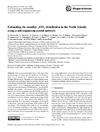Please use this identifier to cite or link to this item:
https://accedacris.ulpgc.es/jspui/handle/10553/49812
| Title: | Estimating the monthly pCO2 distribution in the North Atlantic using a self-organizing neural network | Authors: | Telszewski, M. Chazottes, A. Schuster, U. Watson, A. J. Moulin, C. Bakker, D. C. E. González-Dávila, M. Johannessen, T. Körtzinger, A. Lüger, H. Olsen, A. Omar, A. Padin, X. A. Ríos, A. F. Steinhoff, T. Santana-Casiano, M. Wallace, D. W.R. Wanninkhof, R. |
UNESCO Clasification: | 251002 Oceanografía química | Keywords: | Ciclo del carbono Biogeoquímica Atlántico Norte |
Issue Date: | 2009 | Project: | Ctm2005-03893/Mar. Intercambio de Co2 Atmosfera-Oceano Haciendo Uso de Un Barco Comercial de Observacion Entre Canarias y Barcelona Marine Carbon Sources And Sinks Assessment (Carboocean) |
Journal: | Biogeosciences | Abstract: | Here we present monthly, basin-wide maps of the partial pressure of carbon dioxide (pCO2) for the North Atlantic on a 1° latitude by 1° longitude grid for years 2004 through 2006 inclusive. The maps have been computed using a neural network technique which reconstructs the non-linear relationships between three biogeochemical parameters and marine pCO2. A self organizing map (SOM) neural network has been trained using 389 000 triplets of the SeaWiFS-MODIS chlorophyll-a concentration, the NCEP/NCAR reanalysis sea surface temperature, and the FOAM mixed layer depth. The trained SOM was labelled with 137 000 underway pCO2 measurements collected in situ during 2004, 2005 and 2006 in the North Atlantic, spanning the range of 208 to 437 μatm. The root mean square error (RMSE) of the neural network fit to the data is 11.6 μatm, which equals to just above 3 per cent of an average pCO2 value in the in situ dataset. The seasonal pCO2 cycle as well as estimates of the interannual variability in the major biogeochemical provinces are presented and discussed. High resolution combined with basin-wide coverage makes the maps a useful tool for several applications such as the monitoring of basin-wide air-sea CO2 fluxes or improvement of seasonal and interannual marine CO2 cycles in future model predictions. The method itself is a valuable alternative to traditional statistical modelling techniques used in geosciences. | URI: | https://accedacris.ulpgc.es/handle/10553/49812 | ISSN: | 1726-4170 | DOI: | 10.5194/bg-6-1405-2009 | Source: | Biogeosciences [ISSN 1726-4170], v. 6 (8), p. 1405-1421 | Rights: | by-nc-nd |
| Appears in Collections: | Artículos |
SCOPUSTM
Citations
102
checked on Jun 8, 2025
WEB OF SCIENCETM
Citations
95
checked on Jun 8, 2025
Page view(s)
137
checked on Oct 31, 2024
Download(s)
114
checked on Oct 31, 2024
Google ScholarTM
Check
Altmetric
Share
Export metadata
Items in accedaCRIS are protected by copyright, with all rights reserved, unless otherwise indicated.

